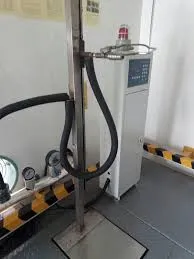335345435
Nov . 07, 2024 14:17 Back to list
Hydraulic Hose Standards and Specifications for SAE100R6 Applications in China
Understanding SAE 100R6 A Comprehensive Overview of Hydraulic Hose Standards
Hydraulic hoses play a crucial role in various mechanical systems, serving as the arteries that transport hydraulic fluids from one component to another. The SAE (Society of Automotive Engineers) standards for hydraulic hoses provide guidelines to ensure safety, reliability, and efficiency in hydraulic systems. Among these standards, SAE 100R6 is particularly significant due to its unique properties and applications.
What is SAE 100R6?
SAE 100R6 is a specific standard established for hydraulic hoses used in low-pressure applications. It is part of the SAE J517 specification, which defines the minimum requirements for the performance of hydraulic hoses used across diverse industries. The designation 100R6 indicates its construction and capability, with 100 denoting the series and R6 referring to the hose's specific characteristics.
The SAE 100R6 hose is constructed from synthetic rubber reinforced with textile fibers, providing flexibility and resilience. This design allows the hose to resist weathering and abrasion, making it suitable for various operating conditions.
Key Features of SAE 100R6 Hoses
1. Flexible Construction One of the standout features of SAE 100R6 hoses is their flexibility. They can bend and maneuver easily, making them ideal for use in tight spaces or areas with dynamic movement.
2. Pressure Rating SAE 100R6 hoses are designed for low-pressure hydraulic applications. They typically operate at pressures up to 150 psi (pounds per square inch), making them suitable for transferring non-hazardous fluids such as water, oil, and some chemicals.
3. Temperature Resistance These hoses can handle a moderate temperature range, typically from -40°F to +212°F (-40°C to +100°C). This temperature tolerance ensures that the hoses remain functional under varying environmental conditions.
4. Durable Materials The synthetic rubber used in SAE 100R6 hoses is resistant to various environmental factors, including ozone and UV radiation. This durability helps extend the service life of the hoses, reducing the frequency of replacements and maintenance.
5. Lightweight Design Compared to other hoses designed for hydraulic applications, SAE 100R6 hoses are relatively lightweight. This characteristic makes them easier to handle, install, and maintain in the field.
china sae100r6

Applications of SAE 100R6 Hoses
The versatility of SAE 100R6 hoses makes them suitable for a range of applications across different industries
- Agriculture In agricultural machinery such as tractors and combines, SAE 100R6 hoses are used for hydraulic systems that control lifting and steering mechanisms. Their flexibility and pressure capability are well-suited for these tasks.
- Industrial Equipment Factories and manufacturing facilities utilize SAE 100R6 hoses in hydraulic machinery that operates under low-pressure conditions for various tasks, including material handling and assembly processes.
- Automotive In automotive applications, these hoses are commonly found in fluid transfer systems, such as power steering and other low-pressure hydraulic setups.
- Construction Construction equipment, like excavators and bulldozers, often employs SAE 100R6 hoses for certain hydraulic functions that do not require high pressure, allowing for efficient operation in rugged environments.
Compliance and Quality Assurance
It is essential to highlight that hoses meeting SAE 100R6 standards undergo rigorous testing and quality control. Manufacturers must adhere to precise specifications regarding materials, dimensions, and performance characteristics. This compliance guarantees that the hoses will perform reliably and safely in their intended applications.
Conclusion
SAE 100R6 hoses serve an important role in hydraulic systems, providing a reliable solution for low-pressure fluid transfer across various industries. Their flexible construction, durability, and versatility make them an invaluable component in agricultural, industrial, automotive, and construction applications. As industries continue to evolve and demand more efficient hydraulic systems, understanding standards like SAE 100R6 becomes increasingly critical for engineers, technicians, and professionals involved in design and maintenance. By adhering to these standards, businesses can ensure the safety and efficiency of their hydraulic systems, ultimately leading to enhanced productivity and reduced operational costs.
-
SAE 100 R17 Black Smooth Cover Hydraulic Hose
NewsMar.07,2025
-
SAE 100 R17 Black Smooth Cover Hydraulic Hose
NewsMar.07,2025
-
SAE 100 R17 Black Smooth Cover Hydraulic Hose
NewsMar.07,2025
-
SAE 100 R17 Black Smooth Cover Hydraulic Hose
NewsMar.07,2025
-
SAE 100 R17 Black Smooth Cover Hydraulic Hose
NewsMar.07,2025
-
steel wire braided hydraulic hose
NewsMar.07,2025



